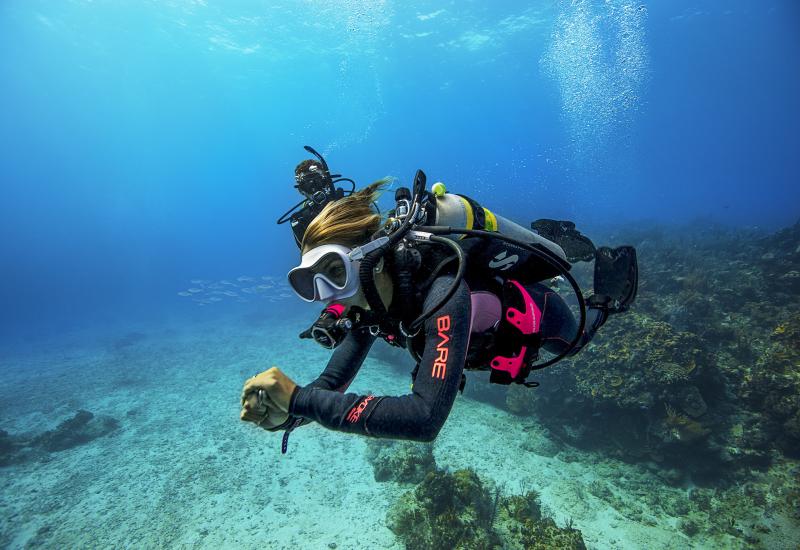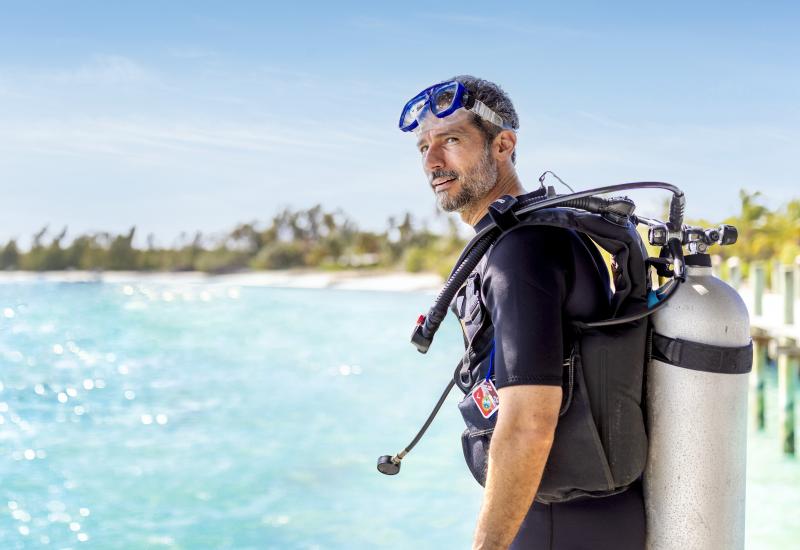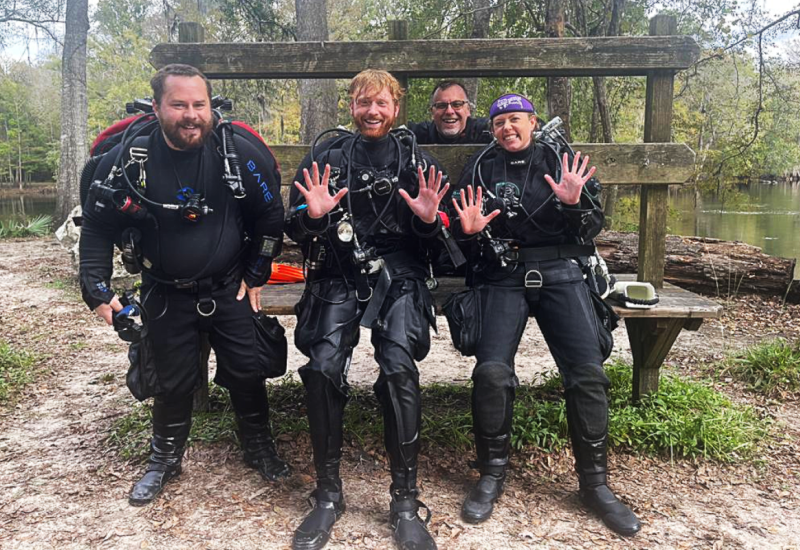Penetrating Questions
Whether it's a historic vessel lost to the indignities of war and weather, or an everyday freighter sunk as a diver's playground, there's something about wreck diving that gets a diver's blood bubbling--in a good way. It can also be one of the most dangerous pursuits in diving, especially when divers penetrate a wreck's interior without proper training and gear.
Open Water Wreck Diving
The first step to safely diving wrecks is entry-level wreck diving certification. Offered by recreational training agencies, this course teaches you to identify and deal with common hazards found when diving the exterior of a shipwreck. These hazards include disorientation, sharp metal edges and entanglement hazards created by rigging, nets and monofilament line.
In addition to making exterior explorations safer, an entry-level wreck diving course is also a good first step to advanced levels of wreck diving. Your training dives in an open-water wreck diving course focus on surveying the wreck to identify all potential hazards and proper navigation techniques to help you maintain a constant awareness of your position on the wreck relative to the ascent line. The metal in the shipwreck can make your compass virtually useless for navigating, so this part of the class focuses on natural navigation cues.
Limited Penetration
The next level of training teaches skills for limited penetration. Limited-penetration divers typically use traditional recreational equipment, although some also carry a wreck reel for primary navigation. While limited-penetration courses are offered by most recreational and technical training agencies, the definition of limited penetration is not clear-cut. Most technical agencies define limited penetration as swimming into simple swim-through areas where the risk of entanglement and entrapment is minimal and the diver can remain inside the natural light zone created by the entry area. Limited-penetration divers should never rely on light streaming through portholes or other nonpassable openings and should always keep the entry/exit point in easy view.
The biggest potential hazard for the limited-penetration diver is loss of vision. The clear water inside the wreck will nearly always be clouded by rust particles, silt and other sediments when you turn to exit. Poor buoyancy control, poor fin technique and even your exhaust bubbles will cause this diminished visibility by kicking up sand and silt, and dislodging sediments from rusting steel plates overhead.
These clouds of silt and sediment can range from a minor annoyance to a disorienting hazard that completely robs you of the ability to see. To alleviate these problems, limited-penetration divers are trained to penetrate only open passages that have large openings for access and preferably more than one opening for entry and exit.
Full Penetration
The most advanced form of wreck diving is full-penetration or technical wreck diving. At this level, divers are trained to penetrate to any level of the ship provided that the structure is stable and the dive is within the skill and experience level of the diver.
The penetration diver must have skills very similar to those used in cave diving, and he assumes that every wreck dive will be a decompression dive. Therefore, most training programs go beyond penetration skill to include gas management techniques and the use of decompression gases to facilitate staged decompression stops during the ascent. This training often includes use of a lift bag or surface marker to allow the dive boat to track the diver's location if he is forced to decompress while drifting. In addition to a stage tank and a surface marker, the penetration diver will replace his primary cylinder with either a high-capacity (98 to 120 cubic feet) single cylinder with an H valve or a twin cylinder configuration utilizing an isolation manifold with two regulator connection outlets. Either of these tank configurations will allow the diver to both carry more gas and to carry a complete, separate regulator system consisting of a first stage and second stage connected by a five- to seven-foot-long hose.
If the diver should find himself inside the wreck and experience a catastrophic failure in one regulator system (such as an uncontrolled second stage free flow), the diver can simply shut down the malfunctioning regulator and switch to the backup. This will allow the diver to preserve his gas supply for exiting the wreck without having to share gas with a buddy. If the situation becomes even worse and the diver finds his primary gas supply completely exhausted, the seven-foot hose allows the diver's buddy to share gas even if the divers have to pass through restricted passageways one behind the other.Penetration divers also use a conservative gas management technique called the rule of thirds. In very simple terms, this means that the diver uses one-third of his gas as he swims away from the exit point, one-third of his gas to return to the exit point, and saves one-third of his gas to deal with any emergencies that may occur.
The full-penetration diver will use wreck reels and line markers to safely navigate inside the wreck. During the course of penetration, the divers will survey the structure of the wreck to look for loose or unstable structures and alternative paths to open water should the primary entry route become impassable.
Technical wreck dives can be done on any intact structure; however, divers pursuing this passion frequently discover that deeper wrecks offer the most potential. Therefore, most technical wreck divers will also get training in extended-range or tri-mix diving in order to access wrecks in the 150- to 330-foot range.
Whether it's a historic vessel lost to the indignities of war and weather, or an everyday freighter sunk as a diver's playground, there's something about wreck diving that gets a diver's blood bubbling--in a good way. It can also be one of the most dangerous pursuits in diving, especially when divers penetrate a wreck's interior without proper training and gear.
Open Water Wreck Diving
The first step to safely diving wrecks is entry-level wreck diving certification. Offered by recreational training agencies, this course teaches you to identify and deal with common hazards found when diving the exterior of a shipwreck. These hazards include disorientation, sharp metal edges and entanglement hazards created by rigging, nets and monofilament line.
In addition to making exterior explorations safer, an entry-level wreck diving course is also a good first step to advanced levels of wreck diving. Your training dives in an open-water wreck diving course focus on surveying the wreck to identify all potential hazards and proper navigation techniques to help you maintain a constant awareness of your position on the wreck relative to the ascent line. The metal in the shipwreck can make your compass virtually useless for navigating, so this part of the class focuses on natural navigation cues.
Limited Penetration
The next level of training teaches skills for limited penetration. Limited-penetration divers typically use traditional recreational equipment, although some also carry a wreck reel for primary navigation. While limited-penetration courses are offered by most recreational and technical training agencies, the definition of limited penetration is not clear-cut. Most technical agencies define limited penetration as swimming into simple swim-through areas where the risk of entanglement and entrapment is minimal and the diver can remain inside the natural light zone created by the entry area. Limited-penetration divers should never rely on light streaming through portholes or other nonpassable openings and should always keep the entry/exit point in easy view.
The biggest potential hazard for the limited-penetration diver is loss of vision. The clear water inside the wreck will nearly always be clouded by rust particles, silt and other sediments when you turn to exit. Poor buoyancy control, poor fin technique and even your exhaust bubbles will cause this diminished visibility by kicking up sand and silt, and dislodging sediments from rusting steel plates overhead.
These clouds of silt and sediment can range from a minor annoyance to a disorienting hazard that completely robs you of the ability to see. To alleviate these problems, limited-penetration divers are trained to penetrate only open passages that have large openings for access and preferably more than one opening for entry and exit.
Full Penetration
The most advanced form of wreck diving is full-penetration or technical wreck diving. At this level, divers are trained to penetrate to any level of the ship provided that the structure is stable and the dive is within the skill and experience level of the diver.
The penetration diver must have skills very similar to those used in cave diving, and he assumes that every wreck dive will be a decompression dive. Therefore, most training programs go beyond penetration skill to include gas management techniques and the use of decompression gases to facilitate staged decompression stops during the ascent. This training often includes use of a lift bag or surface marker to allow the dive boat to track the diver's location if he is forced to decompress while drifting. In addition to a stage tank and a surface marker, the penetration diver will replace his primary cylinder with either a high-capacity (98 to 120 cubic feet) single cylinder with an H valve or a twin cylinder configuration utilizing an isolation manifold with two regulator connection outlets. Either of these tank configurations will allow the diver to both carry more gas and to carry a complete, separate regulator system consisting of a first stage and second stage connected by a five- to seven-foot-long hose.
If the diver should find himself inside the wreck and experience a catastrophic failure in one regulator system (such as an uncontrolled second stage free flow), the diver can simply shut down the malfunctioning regulator and switch to the backup. This will allow the diver to preserve his gas supply for exiting the wreck without having to share gas with a buddy. If the situation becomes even worse and the diver finds his primary gas supply completely exhausted, the seven-foot hose allows the diver's buddy to share gas even if the divers have to pass through restricted passageways one behind the other.Penetration divers also use a conservative gas management technique called the rule of thirds. In very simple terms, this means that the diver uses one-third of his gas as he swims away from the exit point, one-third of his gas to return to the exit point, and saves one-third of his gas to deal with any emergencies that may occur.
The full-penetration diver will use wreck reels and line markers to safely navigate inside the wreck. During the course of penetration, the divers will survey the structure of the wreck to look for loose or unstable structures and alternative paths to open water should the primary entry route become impassable.
Technical wreck dives can be done on any intact structure; however, divers pursuing this passion frequently discover that deeper wrecks offer the most potential. Therefore, most technical wreck divers will also get training in extended-range or tri-mix diving in order to access wrecks in the 150- to 330-foot range.










